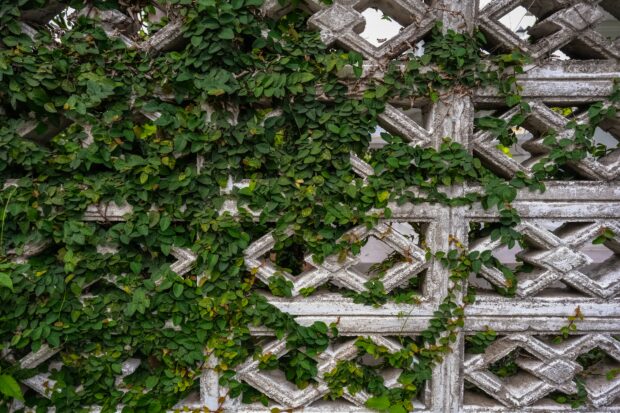You have no items in your cart. Want to get some nice things?
Go shopping
The wall has come together over many generations. First, the flint base, a layer of fist-sized, glassy cobbles. Then stone, boxed chunks of it, the same sickly grey as the Chapel of Our Lady – or what’s left of it in that rubble pile, sprung all over with nettles and creepers, a few fields away. Next is brick: flat red Tudor tiles, sandwich-thick, and ruddy Victorian kiln-fired brick, mottled and liver-spotted with age. Cement-and-rubble-patches plug gaps where the wall has narrowed and sunk. The top is banked up with whatever’s come to hand: shingles of slate, bottles, broken pot. This is not a wall for scaling.
The wall is stitched together with ivy: not so much a climbing plant as a tangle of limbs branching and pushing through the mass. The stems are thick as thumbs. At the base of the wall, the foliage is so dense it’s impossible to see where the plant begins. Layers and layers of suckers have scaled up and pooled back down, rooting themselves in the ground until a second wall, green and glossy and knitted with webs, stands before it. Both wall and ivy cladding are the work of ages.
The wall runs along the edge of the field, bordering part of Hill’s garden. It peters out at the crossroads just below the village, ending in a craggy line where a gate or archway once stood. Hill can see into the field from the upper rooms of the cottage. A thick steward margin stands on the far side of the wall, a wide belt of unploughed soil between the ivy tangle and crop line. Lines of glossy beet leaves crosshatch the field, the damp rows stalked by hunching rooks.
Hill’s garden shears swing long and low in one hand, nudging her shin. Though the ivy hasn’t been trimmed for years, at least there are no brambles. Those spiked limbs have made a season’s headway on the shed, hump-backing the roof with arches of thorn and ripping at the felt. But there are no brambles on or near the wall.
Where to start? Hill scuffs a boot at the lawn’s edge. The grass was knee-high beside the wall before Mr Bailey, the local odd-jobber who’d been helping out, agreed to trim it. Even then there were no brambles. No chickweed or thistles or dandelions. No alexanders. Not even bindweed. Nothing has seeded in the grass; nothing has taken root in the wall. The ivy is like a shield.
Mr Bailey wouldn’t tackle the ivy himself. Hill offered him an extra day’s work to do it, but he said it was best to give the wall a wide berth. Hill said she wanted to make a feature of the wall, and if part of the ivy could be cleared, she reasoned, at least at the near end, then something else could be grown against it. A clematis perhaps. Mr Bailey said that disturbing the ivy would do more harm than good and that if part of the wall should come down, it would be a job and a half to fix.
Hill does not wish to make a feature of the wall. It is hideous. Hateful. She wants to tear it down, knock through it, level it and skip the rubble. The top of the wall is little more than a spoil heap. It is not a scheduled monument; no regulations protect it. But she knows it’s impossible. The wall abuts the field and she would need permission from the farmers to clear and replace it, agree the details of demolition and removal, arrange access for trucks in the field, compensate for any damage or inconvenience.
For now, she can only tackle the ivy, but it’s a start. It isn’t safe to take a strimmer to it, not with all those loose stones and the possibility of hidden glass or metal. It’s the shears or nothing.
Hill gets to work.
The keys have been theirs for a week now. A lot of the furniture has gone. Hill has kept the pieces worth saving: the dresser, built to fit the space; the workmanlike kitchen table; the old fireplace and mantelpiece. The cottage is attractive enough and the setting rustic, even if the village is little more than a residential street now, the shop and single pub long converted to housing. Hill will pitch the place as a get-away, an escape from the bustle, a chance to return to a simpler life. The nearest decent supermarket is fifteen miles away but there’s a small town just up the road with a couple of cafes and a convenience store. There are footpaths to explore and a reservoir for fishing. Robert’s aunt employed a local cleaner towards the end, and Hill has already arranged with her to see to the place between bookings.
Robert is keen for the place to pay for itself; says it’s impossible they will ever live here. Hill has made improving the cottage her project: a place to exert her control, her taste. At first she pictured spending long weekends in the cottage, imagined rambling country walks around the lanes, returning to a casserole in the oven, a stack of logs and a pile of books to read. She saw herself alone here, lying in a bed heaped with blankets, listening in the dark to the creak of frost on the windows, the hoot of a tawny owl hunting. Robert did not feature in those fantasies. Robert did not exist outside the city.
Could she? The longer Hill is here, the more she misses the flat. Not the space itself, but the reassuring trappings of routine. Coffee from the deli at the end of the street. The bus grinding through morning traffic. The grim, silent camaraderie of the daily commute. She will not admit it, but perhaps Robert is right. Perhaps she is not cut out for the cultural privations of country living. But her job is soulless: pointless, purposeless. Her labour makes no discernible impact on the world. Who would care if she never returned? What difference would it make to anyone? She could stay here in the country and let it winnow her to nothingness.
Well, she is here now. She will shape the place and leave this trace of herself, if nothing else.
Hill hacks at the ivy for an hour or so. It’s hot work and every now and then she wipes sweat and dust from her eyebrows. Even so, she hasn’t made much of a dent in the foliage, just a shallow square. Her nose itches. She rubs at it with the back of her gardening glove, smells the bitter crushed juices of ivy, acrid on soft leather.
She’s given up looking for the base of the plant. Anything above chest height will eventually come down when she cuts through the lower layers. She’d hoped to tug out some of the length as she went, cutting the ivy off at the waist and reeling it towards her, but the tangle is so dense she can’t pull anything free. Instead, she is barely sculpting it.
Hill steps back from the puddle of glossy leaves at her feet. Maybe if she waits, the severed lengths will dry out and come free. A week or two of weather might see to it. She studies the thick cobwebs in the flint of the wall: for all these nests, she has yet to see a spider.
Hill tests the depth of the ivy with her arm. She can’t quite reach the stone of the wall, but she’s close. She wiggles her gloved fingers towards it. There’s something small and white in there, resting, just to the right and out of reach, between two stone blocks. Not resting – hanging, suspended in the ivy. Something about the size of a ping pong ball. Hill retreats to pick up her shears and presses back into the mass, parting the curtain of foliage with the tool’s long, scissored points. She wiggles a gap in the ivy wide enough to see the object clearly. A small bird’s skull.
The poor thing must have nested against the wall and died there. The ivy has pushed through an eye socket, threading a bead. Hill can see no skeleton; maybe there is only a head, the abandoned trophy of a cat kill. The cat must have left it on top of the wall and it fell down into the ivy. Or the plant, leafy fingers reaching, picked up the skull and carried it as it grew.
Hill is exhausted. Her head throbs from exertion and concentration. She sneezes; stretches; yawns. It’s already getting dark. She toes the shorn leaves together into a small pile and heads back to the house.
It takes Hill three days to make any kind of hole in the ivy. Robert is back at work, too busy to take more leave. It’s up to Hill to keep going with improvements on her own, which suits her just fine. There isn’t much she can do in the house yet, not until new furniture arrives. It makes sense for her to carry on working in the garden.
Hill feels the woozy fog of an impending cold: it’s typical she should get sick when using up precious holiday allowance. She must have disturbed an allergen of some sort too, because a raised rash has planted itself just above her wrist. The rash has tracked its way, dogged, day by day, along the inside of her right arm.
Hill’s nose streams and her breathing grows ragged. But the cold fresh air is surely good for her, so each day she works a little in the garden, hacks a little more at the ivy. At night she sleeps propped up against pillows, almost seated. Her dreams are gothic: of sinking into a thrashing sea; of dust and cobwebs and sheets draped over furniture. Of a living burial she cannot prevent, a distant rectangle of daylight above her, Robert’s face long and pale looking away as he scatters her with handfuls of soil and leaf mould. She wakes in the early hours, gasping, swollen-mouthed.
Robert calls on Thursday evening. He has a late finish the next day. There is so much for him to clear that he will need to work on Saturday. It hardly seems sensible for him to make the journey to the cottage, not just for one night. He would have to leave again on Sunday afternoon anyway. Hill listens. She holds the receiver away and breathes through her mouth. She does not want him to hear the crackling of her lungs, the thickness of her phlegmy voice, the unspoken suggestion of her not-coping. She hums responses: hmm, all is fine. Huh-hmm, she is making progress. Nuh-hmm, she doesn’t need him to be there.
He doesn’t want to come and she doesn’t need him hovering around, judging what she has or hasn’t achieved, expecting meals, criticising her decisions or her ragged, raw-nosed appearance. They are both keen to keep the call short.
The next morning, Hill stares at the wall through the kitchen window, sipping a mug of coffee she can barely taste. She is not making progress. She will not let him see that. She will not let this ivy defeat her.
Hill applies a layer of antiseptic cream to the rash on her arm. The red bumps are disturbing to touch, the feel of blood so close to the surface, the puckered skin rippling pale then blushing again as she rubs in the cream. The bumps have started to join together, clustering, converging, forming meandering tracks connecting dense constellations of blistering, fluid-filled crimson. The cream stings and sticks Hill’s prickling flesh to the inside of her shirtsleeve. It aches to raise her arm. But Hill is determined. She takes the heavy shears from their hook and returns to face down the wall.
In the late morning she finds a decaying mouse, hanging, like the bird skull, in a looped stitch of ivy. Another cat victim? As the light starts to seep away and the shadow of the wall spills into the garden she finds a dead rabbit, back foot caught in a snare of foliage. It has been there a while, the body parched and leathery, but patches of the underbelly fur and tail are still white in places, still heartbreakingly bunnyish and soft. It must have come from the field and squeezed through a gap in the wall. Did it get tangled and break its leg? Was it sick or wounded, holing up somewhere safe, buried in the dense green to escape a predator? Hill shudders as she cuts the ivy away from the small body and it falls, slight and loose, into a pile of trimmings. She fetches a spade, scoops the creature up, cradled in the wide cup of blade, and carries it to a flowerbed. She digs a hole beside a rhododendron and tips it in.
Hill coughs hard that night: a wet, wracking cough that makes her back and sides ache.
On Saturday morning her glands are swollen. She takes three paracetamol and wraps a scarf around her neck. She stands at the window and looks out at the wall, shifting, unsteady, from foot to foot. Her mouth tastes rusty, astringent. She spits into the sink and turns the tap on hard, looking away, terrified of the poisons exiting her body.
On Saturday evening, Hill finds a fox. At first she thinks it might be a cat, the villain responsible for those smaller kills, but then she sees the orange brush of tail poking through gaps in the plaited ivy. The plant has twined itself round and round the fox’s body like a child wrapping string around a parcel. She tugs at the encircling ivy with her shears. Part of it falls away and the fox’s head droops and swings. She turns aside and vomits onto the grass.
On Sunday morning, Hill’s right armpit is aching and swollen. She has trouble swallowing painkillers. She cannot raise the shears above knee height; cannot bear to remove the fox; cannot bring herself to work on the same patch of ivy. She snips at a low piece of foliage, skirting the grass. She coughs and coughs: and spits blood.
Fear pricks her. She bends over, hands on knees, pinpricks of light clustering in her vision. Standing again she drops the shears, rocks and sways.
Hill lists to one side, striking out her left hand to catch herself. Her gloved palm reaches into the mesh of ivy; through it; meets the wall. She hears the delicate crunch of contact; feels a tearing and searing ripple through her from wrist to shoulder to neck.
The numbing embrace of the ivy supports her torso, cushioning, drawing her in to rest. Her head swims as she sinks in, down, luxuriating. Dust and trapped pollen, soil and wood and sap-spice: she breathes it in, deep. Yes, she thinks, time to let go, time to make peace. She sees the shape of the cottage at the far end of the garden, blurring, beyond the ivy net. It will always be Robert’s cottage. But here it is soft, so soft and shielded beneath the lush dappling, not hostile and other but ageless, timeless. Vegetal. Yes, she will stay. It will always be there to console her, to keep her close to the wall and the earth beneath it; to hold her, comforting and containing, the shallow breaths of grit and greenness slowing, slowing, unfurling into leaf.
About Sonia Overall
Dr Sonia Overall is a writer, psychogeographer and academic living in East Kent. Her published work includes novels, poetry, short stories, academic articles and features, many of which explore place, the nonhuman, aspects of the weird and experimental forms. Her short fiction and poetry have appeared in Streetcake, Neon, Lune, Shearsman Magazine and Seaside Gothic; her books include the poetry chapbook The Art of Walking, walking-writing manual walk write (repeat), pilgrimage memoir Heavy Time and her latest novel, Eden. Sonia is currently a Reader in Creative Writing at Canterbury Christ Church University.




